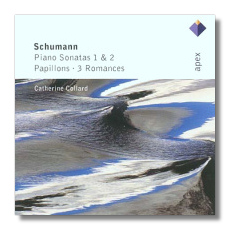
The Internet's Premier Classical Music Source
Related Links
- Schumann Reviews
- Latest Reviews
- More Reviews
-
By Composer
-
Collections
DVD & Blu-ray
Books
Concert Reviews
Articles/Interviews
Software
Audio
Search Amazon
Recommended Links
Site News
 CD Review
CD Review
Robert Schumann

Piano Music
- Piano Sonata #1 in F Sharp minor, Op. 11 (32:11) *
- Piano Sonata #2 in G minor, Op. 22 (17:42)
- Papillons, Op. 2 (13:46)
- 3 Romances, Op. 28 (13:54)
Catherine Collard, piano
Recorded at Salon Honnorat, Cite Universitaire, Paris, in March 1978
* Recording Location/Dates Not Identified
Warner Apex 2564-61797-2 78:04
Comparisons:
Sonata #1 – Gilels/Classica D'Oro; Glemser/Naxos; Pollini/DG; Wirssaladze/Live Classics
Sonata #2 – Berezovsky/Teldec; Blanchard/Vanguard; Kempff/DG; Wirssaladze/Live Classics
Papillons – Freire/Decca; Richter/EMI
3 Romances – Kempff/DG; Nat/EMI
Born in 1947, Catherine Collard was a splendid French pianist who died from cancer in 1993. I first became familiar with her artistry through her Haydn Piano Sonata recordings for the Lyrinx label, and upon further investigation found her recordings of Debussy, Faure, D'Indy and Satie also highly rewarding. Warner recently reissued this Schumann disc that further confirms that Collard's early demise was a sad day for keyboard enthusiasts.
Collard's best performances on the disc are of the 3 Romances. These pieces are not among Schumann's most popular piano works, but each of the three is compelling music fully possessing the gorgeous musical lines, impetuosity, and contrasting of action/enlightenment that Schumann is so well known for. The 1st Romance, "Sehr markiert", is full of tension and restlessness, and Collard gives the most urgent performance on record with triplet cascades in constant distress. "Einfach", the 2nd Romance, is a beautiful piece where Schumann comforts us with his hymn-like phrasing and pacing; Collard excellently captures the security of the music, although she can't match Wilhelm Kempff's mesmerizing account. The 3rd Romance is a rather extended contrapuntal affair with two Intermezzos and a wealth of varied themes and emotional content. As in the 1st Romance, Collard is superb as she highlights Schumann's vigor and playfulness in the primary theme, the enchanting nature of the Intermezzo I and the frenetic energy of Intermezzo II. Overall, I find Collard's readings of the Romances the most rewarding available on the market. Although the recorded competition is not huge for these pieces, the exceptional versions by Kempff and Nat are hard to beat, and Collard does just that with a superior achievement.
Schumann's Papillons, like his more extended Carnaval, revolves around a masked ball where layers of emotions are impetuously uncovered and displayed. Collard gives another winning performance. She does not match the magnificent Richter interpretation or the spontaneity of the Freire, but her well characterized reading is among the better versions in the catalogues.
Schumann began work on his Sonata #2 in the same year as #1, but his second effort displays a greater command of sonata form and he was able to fully convey his musical fantasy within the sonata's architectural boundaries. Schumann's two alter-egos, Florestan (man of action) and Eusebius (enlightenment) are constant fixtures in the four-movement work. Eusebius is the central personality in the lovely and reflective 2nd Movement Andantino, but Florestan grabs the other movements by the throat. The 1st Movement is especially angry and angst-ridden, the very short 3rd Movement Scherzo amazingly contains two Trios, and the 4th Movement Rondo requires great virtuosity with its speeding figures.
An excellent performance of Sonata #2 must convey Florestan's tremendous strength and immediate response to stimuli as well as the measured guidance handed down by Eusebius. Collard does all this with a tempestuous and muscular Florestan countered by an insightful and spiritual Eusebius. I particularly love her 1st Movement where Florestan is in charge of a world out of control; Collard's ferocious and helter-skelter display is just the ticket for this music. Her version of the Sonata easily stands tall next to the exceptional comparison recordings.
I am not as enthusiastic concerning Collard's performance of the Sonata #1 in F Sharp minor, and my reservations apply to the 1st Movement with its Introduction of brutal intensity and the first theme's wildly sinister dance rhythms. Each of the comparison versions fully conveys these features, especially the scorching Gilels and Wirssaladze interpretations. Unfortunately, there is nothing scorching about Collard's performance. Her introduction is relatively benign, and the necessary tension that builds in the beginning of the Allegro vivace is absent.
Don's Conclusions: This reissued Collard disc has much to offer with the exception of the 1st Movement of Sonata #1. Given the super-budget price tag and clear sonics, I heartily recommend the recording. If the 3 Romances are your main priority, Collard becomes essential listening. Although the disc has not been distributed in the U.S. market, it is readily available from various European sources including Amazon UK.
Copyright © 2005/2006, Don Satz


















